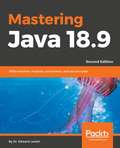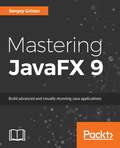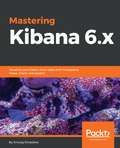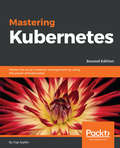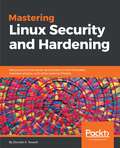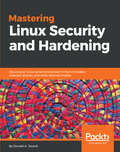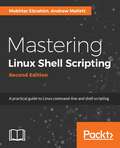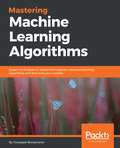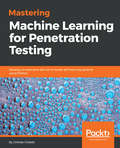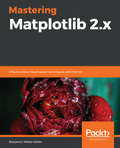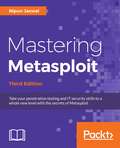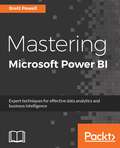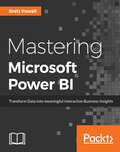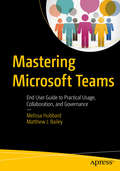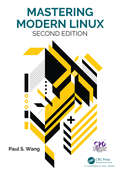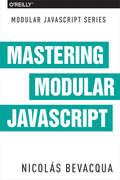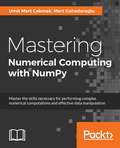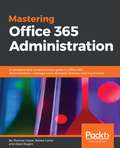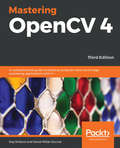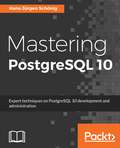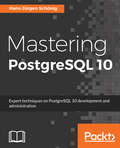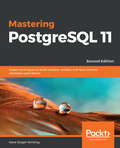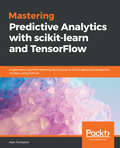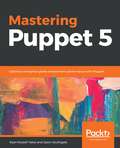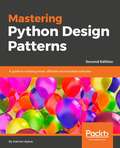- Table View
- List View
Mastering Java 11: Develop modular and secure Java applications using concurrency and advanced JDK libraries, 2nd Edition
by Dr Edward LavieriUpdate your Java knowledge with the latest features of Java 11, such as the low-Overhead Garbage Collector, Local-Variable Syntax for Lambda Parameters, and Dynamic Class-File ConstantsKey FeaturesExplore the latest features in Java 9,Java 10, and Java 11Enhance your Java application development and migration approaches Full coverage of modular Java applications, G1 Garbage Collector, JMHBook DescriptionJava 11 is a long-term release and its new features add to the richness of the language. It emphasizes variable-type inference, performance improvements, along with simplified multithreading.The Java platform has a special emphasis on modularity, making this the programming platform of choice for millions of developers. The modern Java platform can be used to build robust software applications, including enterprise-level and mobile applications. Fully updated for Java 11, this book stands to help any Java developer enjoy the richness of the Java programming language.Mastering Java 11 is your one-stop guide to fully understanding recent Java platform updates. It contains detailed explanations of the recent features introduced in Java 9, Java 10, and Java 11 along with obtaining practical guidance on how to apply the new features. As you make your way through the chapters, you'll discover further information on the developments of the Java platform and learn about the changes introduced by the variable handles and Project Coin, along with several enhancements in relation to import statements processing. In the concluding chapters, you'll learn to improve your development productivity, making your applications more efficient. You'll also be able to get to grips with the command-line flags with respect to various utilities and the command-line utility changes featured in the current Java platform. By the end of the book, you'll have obtained an advanced level understanding of the Java platform and its recent changes.What you will learnWrite modular Java applicationsMigrate existing Java applications to modular onesUnderstand how the default G1 garbage collector worksLeverage the possibilities provided by the newly introduced Java ShellPerformance test your application effectively with the JVM harnessLearn how Java supports the HTTP 2.0 standardFind out how to use the new Process APIExplore the additional enhancements and features of Java 9, 10, and 11Who this book is forMastering Java 11 is for experienced Java developers with a solid understanding of the Java language and want to progress to an advanced level.
Mastering JavaFX 10: Build advanced and visually stunning Java applications
by Sergey GrinevDesign modern, rich interfaces for Java apps using JavaFX 10Key FeaturesLeverage advanced GUI programming techniques using the latest JavaFX 10 framework.Create dynamic content using the animation API and work with different application layersCreate and customize plugins and use them efficiently in different applicationsBook Description: JavaFX 10 is used to create media-rich client applications. This book takes you on a journey to use JavaFX 10 to build applications that display information in a high-performance, modern user interface featuring audio, video, graphics, and animation.Mastering JavaFX 10 begins by introducing you to the JavaFX API. You will understand the steps involved in setting up your development environment and build the necessary dependencies. This is followed by exploring how to work with the assets, modules, and APIs of JavaFX. This book is filled with practical examples to guide you through the major features of JavaFX 10. In addition to this, you will acquire a practical understanding of JavaFX custom animations, merging different application layers smoothly, and creating a user-friendly GUI with ease. By the end of the book, you will be able to create a complete, feature-rich Java graphical application using JavaFX.What you will learnConstruct and customize JavaFX windowsManage UI elements and arrange them on the SceneExplore the Bindings API and use it to coordinate various UI elementsUse FXML to design amazing FX applicationsWrite and manage CSS to style your applicationsAdd audio and video to your projectsPrepare your application to be launched on the target platformWho this book is forIf you’re a Java developer who wants to upgrade to the latest version of JavaFX to create stunning, feature-rich graphical applications, this book is for you. Some basic knowledge of Java programming is necessary to get the most out of this book. prior JavaFX knowledge will help but is not mandatory.
Mastering Kibana 6.x: Visualize your Elastic Stack data with histograms, maps, charts, and graphs
by Anurag SrivastavaGet to grips with Kibana and its advanced functions to create interactive visualizations and dashboardsKey FeaturesExplore visualizations and perform histograms, stats, and map analyticsUnleash X-Pack and Timelion, and learn alerting, monitoring, and reporting featuresManage dashboards with Beats and create machine learning jobs for faster analyticsBook DescriptionKibana is one of the popular tools among data enthusiasts for slicing and dicing large datasets and uncovering Business Intelligence (BI) with the help of its rich and powerful visualizations.To begin with, Mastering Kibana 6.x quickly introduces you to the features of Kibana 6.x, before teaching you how to create smart dashboards in no time. You will explore metric analytics and graph exploration, followed by understanding how to quickly customize Kibana dashboards. In addition to this, you will learn advanced analytics such as maps, hits, and list analytics. All this will help you enhance your skills in running and comparing multiple queries and filters, influencing your data visualization skills at scale.With Kibana’s Timelion feature, you can analyze time series data with histograms and stats analytics. By the end of this book, you will have created a speedy machine learning job using X-Pack capabilities.What you will learnCreate unique dashboards with various intuitive data visualizationsVisualize Timelion expressions with added histograms and stats analyticsIntegrate X-Pack with your Elastic Stack in simple stepsExtract data from Elasticsearch for advanced analysis and anomaly detection using dashboardsBuild dashboards from web applications for application logsCreate monitoring and alerting dashboards using BeatsWho this book is forMastering Kibana 6.x is for you if you are a big data engineer, DevOps engineer, or data scientist aspiring to go beyond data visualization at scale and gain maximum insights from their large datasets. Basic knowledge of Elasticstack will be an added advantage, although not mandatory.
Mastering Kubernetes: Master the art of container management by using the power of Kubernetes, 2nd Edition
by Gigi SayfanExploit design, deployment, and management of large-scale containersKey FeaturesExplore the latest features available in Kubernetes 1.10Ensure that your clusters are always available, scalable, and up to dateMaster the skills of designing and deploying large clusters on various cloud platformsBook DescriptionKubernetes is an open source system that is used to automate the deployment, scaling, and management of containerized applications. If you are running more containers or want automated management of your containers, you need Kubernetes at your disposal. To put things into perspective, Mastering Kubernetes walks you through the advanced management of Kubernetes clusters.To start with, you will learn the fundamentals of both Kubernetes architecture and Kubernetes design in detail. You will discover how to run complex stateful microservices on Kubernetes including advanced features such as horizontal pod autoscaling, rolling updates, resource quotas, and persistent storage backend. Using real-world use cases, you will explore the options for network configuration, and understand how to set up, operate, and troubleshoot various Kubernetes networking plugins. In addition to this, you will get to grips with custom resource development and utilization in automation and maintenance workflows.To scale up your knowledge of Kubernetes, you will encounter some additional concepts based on the Kubernetes 1.10 release, such as Promethus, Role-based access control, API aggregation, and more. By the end of this book, you’ll know everything you need to graduate from intermediate to advanced level of understanding Kubernetes.What you will learnArchitect a robust Kubernetes cluster for long-time operationDiscover the advantages of running Kubernetes on GCE, AWS, Azure, and bare metalUnderstand the identity model of Kubernetes, along with the options for cluster federationMonitor and troubleshoot Kubernetes clusters and run a highly available KubernetesCreate and configure custom Kubernetes resources and use third-party resources in your automation workflowsEnjoy the art of running complex stateful applications in your container environmentDeliver applications as standard packagesWho this book is forMastering Kubernetes is for you if you are a system administrator or a developer who has an intermediate understanding of Kubernetes and wish to master its advanced features. Basic knowledge of networking would also be helpful. In all, this advanced-level book provides a smooth pathway to mastering Kubernetes.
Mastering Linux Security and Hardening: Secure Your Linux Server And Protect It From Intruders, Malware Attacks, And Other External Threats
by Donald A. TevaultFor the past couple of decades, Linux has been extremely popular with systems administrators, for everything from creating networks and servers to automating their entire working environment. However, security has always been the major concern. With not many resources available in the Linux security domain, this book will be an invaluable resource to help you get your Linux systems properly secured.
Mastering Linux Security and Hardening: Secure your Linux server and protect it from intruders, malware attacks, and other external threats
by Donald A. TevaultA comprehensive guide to mastering the art of preventing your Linux system from getting compromised.Key FeaturesLeverage this guide to confidently deliver a system that reduces the risk of being hackedPerform a number of advanced Linux security techniques such as network service detection, user authentication, controlling special permissions, encrypting file systems, and much moreMaster the art of securing a Linux environment with this end-to-end practical guideBook DescriptionThis book has extensive coverage of techniques that will help prevent attackers from breaching your system, by building a much more secure Linux environment. You will learn various security techniques such as SSH hardening, network service detection, setting up firewalls, encrypting file systems, protecting user accounts, authentication processes, and so on. Moving forward, you will also develop hands-on skills with advanced Linux permissions, access control, special modes, and more. Lastly, this book will also cover best practices and troubleshooting techniques to get your work done efficiently.By the end of this book, you will be confident in delivering a system that will be much harder to compromise.What you will learnUse various techniques to prevent intruders from accessing sensitive dataPrevent intruders from planting malware, and detect whether malware has been plantedPrevent insiders from accessing data that they aren't authorized to accessDo quick checks to see whether a computer is running network services that it doesn't need to runLearn security techniques that are common to all Linux distros, and some that are distro-specificWho this book is forIf you are a systems administrator or a network engineer interested in making your Linux environment more secure, then this book is for you. Security consultants wanting to enhance their Linux security skills will also benefit from this book. Prior knowledge of Linux is mandatory.
Mastering Linux Shell Scripting,: A practical guide to Linux command-line, Bash scripting, and Shell programming, 2nd Edition
by Andrew Mallett Mokhtar EbrahimMaster the complexities of Bash shell scripting and unlock the power of shell for your enterpriseKey FeaturesIdentify high-level steps such as verifying user inputUsing the command line and conditional statements in creating/executing simple shell scriptsCreate and edit dynamic shell scripts to manage complex and repetitive tasksLeverage the command-line to bypass GUI and automate common tasksBook DescriptionIn this book, you’ll discover everything you need to know to master shell scripting and make informed choices about the elements you employ.Grab your favorite editor and start writing your best Bash scripts step by step. Get to grips with the fundamentals of creating and running a script in normal mode, and in debug mode. Learn about various conditional statements' code snippets, and realize the power of repetition and loops in your shell script. You will also learn to write complex shell scripts. This book will also deep dive into file system administration, directories, and system administration like networking, process management, user authentications, and package installation and regular expressions. Towards the end of the book, you will learn how to use Python as a BASH Scripting alternative. By the end of this book, you will know shell scripts at the snap of your fingers and will be able to automate and communicate with your system with keyboard expressions.What you will learnMake, execute, and debug your first Bash scriptCreate interactive scripts that prompt for user inputFoster menu structures for operators with little command-line experienceDevelop scripts that dynamically edit web configuration files to produce a new virtual host Write scripts that use AWK to search and reports on log filesDraft effective scripts using functions as building blocks, reducing maintenance and build timeMake informed choices by comparing different script languages such as Python with BASHWho this book is forIf you are a Linux administrator or a system administrator and are interested in automating tasks in your daily lives, saving time and effort, this book is for you. Basic shell scripting and command-line experience will be required. Familiarity with the tasks you need to automate will be helpful.
Mastering Machine Learning Algorithms: Expert techniques to implement popular machine learning algorithms and fine-tune your models
by Giuseppe Bonaccorso c/o QuandooExplore and master the most important algorithms for solving complex machine learning problems.Key FeaturesDiscover high-performing machine learning algorithms and understand how they work in depth. One-stop solution to mastering supervised, unsupervised, and semi-supervised machine learning algorithms and their implementation. Master concepts related to algorithm tuning, parameter optimization, and moreBook DescriptionMachine learning is a subset of AI that aims to make modern-day computer systems smarter and more intelligent. The real power of machine learning resides in its algorithms, which make even the most difficult things capable of being handled by machines. However, with the advancement in the technology and requirements of data, machines will have to be smarter than they are today to meet the overwhelming data needs; mastering these algorithms and using them optimally is the need of the hour. Mastering Machine Learning Algorithms is your complete guide to quickly getting to grips with popular machine learning algorithms. You will be introduced to the most widely used algorithms in supervised, unsupervised, and semi-supervised machine learning, and will learn how to use them in the best possible manner. Ranging from Bayesian models to the MCMC algorithm to Hidden Markov models, this book will teach you how to extract features from your dataset and perform dimensionality reduction by making use of Python-based libraries such as scikit-learn. You will also learn how to use Keras and TensorFlow to train effective neural networks.If you are looking for a single resource to study, implement, and solve end-to-end machine learning problems and use-cases, this is the book you need.What you will learnExplore how a ML model can be trained, optimized, and evaluatedUnderstand how to create and learn static and dynamic probabilistic modelsSuccessfully cluster high-dimensional data and evaluate model accuracyDiscover how artificial neural networks work and how to train, optimize, and validate themWork with Autoencoders and Generative Adversarial NetworksApply label spreading and propagation to large datasetsExplore the most important Reinforcement Learning techniquesWho this book is forThis book is an ideal and relevant source of content for data science professionals who want to delve into complex machine learning algorithms, calibrate models, and improve the predictions of the trained model. A basic knowledge of machine learning is preferred to get the best out of this guide.
Mastering Machine Learning for Penetration Testing: Develop an extensive skill set to break self-learning systems using Python
by Chiheb ChebbiBecome a master at penetration testing using machine learning with PythonKey Features Identify ambiguities and breach intelligent security systems Perform unique cyber attacks to breach robust systems Learn to leverage machine learning algorithmsBook DescriptionCyber security is crucial for both businesses and individuals. As systems are getting smarter, we now see machine learning interrupting computer security. With the adoption of machine learning in upcoming security products, it’s important for pentesters and security researchers to understand how these systems work, and to breach them for testing purposes. This book begins with the basics of machine learning and the algorithms used to build robust systems. Once you’ve gained a fair understanding of how security products leverage machine learning, you'll dive into the core concepts of breaching such systems. Through practical use cases, you’ll see how to find loopholes and surpass a self-learning security system. As you make your way through the chapters, you’ll focus on topics such as network intrusion detection and AV and IDS evasion. We’ll also cover the best practices when identifying ambiguities, and extensive techniques to breach an intelligent system.By the end of this book, you will be well-versed with identifying loopholes in a self-learning security system and will be able to efficiently breach a machine learning system.What you will learnTake an in-depth look at machine learningGet to know natural language processing (NLP)Understand malware feature engineeringBuild generative adversarial networks using Python librariesWork on threat hunting with machine learning and the ELK stackExplore the best practices for machine learningWho this book is forThis book is for pen testers and security professionals who are interested in learning techniques to break an intelligent security system. Basic knowledge of Python is needed, but no prior knowledge of machine learning is necessary.
Mastering Matplotlib 2.x: Effective Data Visualization techniques with Python
by Benjamin Walter KellerUnderstand and build beautiful and advanced plots with Matplotlib and PythonKey FeaturesPractical guide with hands-on examples to design interactive plotsAdvanced techniques to constructing complex plotsExplore 3D plotting and visualization using Jupyter NotebookBook DescriptionIn this book, you’ll get hands-on with customizing your data plots with the help of Matplotlib. You’ll start with customizing plots, making a handful of special-purpose plots, and building 3D plots. You’ll explore non-trivial layouts, Pylab customization, and more about tile configuration. You’ll be able to add text, put lines in plots, and also handle polygons, shapes, and annotations. Non-Cartesian and vector plots are exciting to construct, and you’ll explore them further in this book. You’ll delve into niche plots and visualize ordinal and tabular data. In this book, you’ll be exploring 3D plotting, one of the best features when it comes to 3D data visualization, along with Jupyter Notebook, widgets, and creating movies for enhanced data representation. Geospatial plotting will also be explored. Finally, you’ll learn how to create interactive plots with the help of Jupyter.Learn expert techniques for effective data visualization using Matplotlib 3 and Python with our latest offering -- Matplotlib 3.0 CookbookWhat you will learnDeal with non-trivial and unusual plotsUnderstanding Basemap methodsCustomize and represent data in 3D Construct Non-Cartesian and vector plotsDesign interactive plots using Jupyter NotebookMake movies for enhanced data representationWho this book is forThis book is aimed at individuals who want to explore data visualization techniques. A basic knowledge of Matplotlib and Python is required.
Mastering Metasploit,: Take your penetration testing and IT security skills to a whole new level with the secrets of Metasploit, 3rd Edition
by Nipun JaswalDiscover the next level of network defense with the Metasploit frameworkKey FeaturesGain the skills to carry out penetration testing in complex and highly-secured environmentsBecome a master using the Metasploit framework, develop exploits, and generate modules for a variety of real-world scenariosGet this completely updated edition with new useful methods and techniques to make your network robust and resilientBook DescriptionWe start by reminding you about the basic functionalities of Metasploit and its use in the most traditional ways. You’ll get to know about the basics of programming Metasploit modules as a refresher and then dive into carrying out exploitation as well building and porting exploits of various kinds in Metasploit.In the next section, you’ll develop the ability to perform testing on various services such as databases, Cloud environment, IoT, mobile, tablets, and similar more services. After this training, we jump into real-world sophisticated scenarios where performing penetration tests are a challenge. With real-life case studies, we take you on a journey through client-side attacks using Metasploit and various scripts built on the Metasploit framework.By the end of the book, you will be trained specifically on time-saving techniques using Metasploit.What you will learnDevelop advanced and sophisticated auxiliary modulesPort exploits from PERL, Python, and many more programming languagesTest services such as databases, SCADA, and many moreAttack the client side with highly advanced techniquesTest mobile and tablet devices with MetasploitBypass modern protections such as an AntiVirus and IDS with MetasploitSimulate attacks on web servers and systems with Armitage GUIScript attacks in Armitage using CORTANA scriptingWho this book is forThis book is a hands-on guide to penetration testing using Metasploit and covers its complete development. It shows a number of techniques and methodologies that will help you master the Metasploit framework and explore approaches to carrying out advanced penetration testing in highly secured environments.
Mastering Microsoft Power BI: Expert Techniques For Effective Data Analytics And Business Intelligence
by Brett PowellThis book will show you how to use Power BI effectively to create a variety of visualizations and BI dashboards. Right from gathering data through various data sources, you will learn to perform effective visual analytics. By the end of this book, you will be able to gain unique, hidden insights into your data using Microsoft Power BI.
Mastering Microsoft Power BI: Expert techniques for effective data analytics and business intelligence
by Brett PowellDesign, create and manage robust Power BI solutions to gain meaningful business insightsKey FeaturesMaster all the dashboarding and reporting features of Microsoft Power BICombine data from multiple sources, create stunning visualizations and publish your reports across multiple platformsA comprehensive guide with real-world use cases and examples demonstrating how you can get the best out of Microsoft Power BIBook DescriptionThis book is intended for business intelligence professionals responsible for the design and development of Power BI content as well as managers, architects and administrators who oversee Power BI projects and deployments. The chapters flow from the planning of a Power BI project through the development and distribution of content to the administration of Power BI for an organization. BI developers will learn how to create sustainable and impactful Power BI datasets, reports, and dashboards. This includes connecting to data sources, shaping and enhancing source data, and developing an analytical data model. Additionally, top report and dashboard design practices are described using features such as Bookmarks and the Power KPI visual. BI managers will learn how Power BI's tools work together such as with the On-premises data gateway and how content can be staged and securely distributed via Apps. Additionally, both the Power BI Report Server and Power BI Premium are reviewed. By the end of this book, you will be confident in creating effective charts, tables, reports or dashboards for any kind of data using the tools and techniques in Microsoft Power BI.What you will learnBuild efficient data retrieval and transformation processes with the Power Query M LanguageDesign scalable, user-friendly DirectQuery and Import Data ModelsDevelop visually rich, immersive, and interactive reports and dashboardsMaintain version control and stage deployments across development, test, and production environmentsManage and monitor the Power BI Service and the On-premises data gatewayDevelop a fully on-premise solution with the Power BI Report ServerScale up a Power BI solution via Power BI Premium capacity and migration to Azure Analysis Services or SQL Server Analysis ServicesWho this book is forBusiness Intelligence professionals and existing Power BI users looking to master Power BI for all their data visualization and dashboarding needs will find this book to be useful. While understanding of the basic BI concepts is required, some exposure to Microsoft Power BI will be helpful.
Mastering Microsoft Teams: End User Guide to Practical Usage, Collaboration, and Governance
by Melissa Hubbard Matthew J. BaileyDo you need to learn how to use Microsoft Teams? Are you questioning how to drive user adoption, govern content, and manage access for your Teams deployment? Either way, Mastering Microsoft Teams is your one-stop-shop to learning everything you need to know to find success with Microsoft Teams. Microsoft’s new chat-based collaboration software has many rich features that enable teams to be more efficient, and save valuable time and resources. However, as with all software, there is a learning curve and pitfalls that should be avoided. Begin by learning the core components and use cases for Teams. From there the authors guide you through ideas to create governance and adoption plans that make sense for your organization or customer. Wrap up with an understanding of features and services in progress, and a road map to the future of the product. What You'll Learn Implement, use, and manage Microsoft TeamsUnderstand how Teams drives productivity and engagement by combining the functionality of Microsoft Groups, SharePoint, OneDrive, Outlook, and other services in one locationGovern, explain, and use Teams in your organizationKnow the pitfalls to avoid that may create challenges in your usage of TeamsBecome familiar with the functionality and components of Teams via walkthroughs, including opportunities for automating business processes in Teams Who This Book Is ForAnyone who wants to learn Microsoft Teams. To get the most out of the book, a basic understanding of Office 365 and a subscription, including a Microsoft Teams license, is useful.
Mastering Modern Linux (Second Edition)
by Paul S. Wang<p>Mastering Modern Linux, Second Edition retains much of the good material from the previous edition, with extensive updates and new topics added. The book provides a comprehensive and up-to-date guide to Linux concepts, usage, and programming. The text helps the reader master Linux with a well-selected set of topics, and encourages hands-on practice. <p>The first part of the textbook covers interactive use of Linux via the Graphical User Interface (GUI) and the Command-Line Interface (CLI), including comprehensive treatment of the Gnome desktop and the Bash Shell. Using different apps, commands and filters, building pipelines, and matching patterns with regular expressions are major focuses. <p>Next comes Bash scripting, file system structure, organization, and usage. The following chapters present networking, the Internet and the Web, data encryption, basic system admin, as well as Web hosting. The Linux Apache MySQL/MariaDB PHP (LAMP) Web hosting combination is also presented in depth. <p>In the last part of the book, attention is turned to C-level programming. Topics covered include the C compiler, preprocessor, debugger, I/O, file manipulation, process control, inter-process communication, and networking. <p>The book includes many examples and complete programs ready to download and run. A summary and exercises of varying degrees of difficulty can be found at the end of each chapter. A companion website (http://mml.sofpower.com) provides appendices, information updates, an example code package, and other resources for instructors, as well as students.</p>
Mastering Modular JavaScript
by Nicolas BevacquaIf you have a working knowledge of JavaScript and ECMAScript 6 (ES6), this practical guide will help you tackle modular programming to produce code that’s readable, maintainable, and scalable. You’ll learn the fundamentals of modular architecture with JavaScript and the benefits of writing self-contained code at every system level, including the client and server.Nicolás Bevacqua, author of Practical Modern JavaScript, demonstrates how to scale out JavaScript applications by breaking codebases into smaller modules. By following the design practices in this book, senior developers, technical leaders, and software architects will learn how to create modules that are simple and flexible while keeping internal complexity in check.Learn modular design essentials, including how your application will be consumed and what belongs on the interfaceDesign module internals to keep your code readable and its intent clearReduce complexity by refactoring code and containing and eliminating stateTake advantage of modern JavaScript features to write clear programs and reduce complexityApply Twelve-Factor App principles to frontend and backend JavaScript application development
Mastering Numerical Computing with NumPy: Master scientific computing and perform complex operations with ease
by Umit Mert Cakmak Mert CuhadarogluEnhance the power of NumPy and start boosting your scientific computing capabilitiesKey FeaturesGrasp all aspects of numerical computing and understand NumPyExplore examples to learn exploratory data analysis (EDA), regression, and clusteringAccess NumPy libraries and use performance benchmarking to select the right toolBook DescriptionNumPy is one of the most important scientific computing libraries available for Python. Mastering Numerical Computing with NumPy teaches you how to achieve expert level competency to perform complex operations, with in-depth coverage of advanced concepts.Beginning with NumPy's arrays and functions, you will familiarize yourself with linear algebra concepts to perform vector and matrix math operations. You will thoroughly understand and practice data processing, exploratory data analysis (EDA), and predictive modeling. You will then move on to working on practical examples which will teach you how to use NumPy statistics in order to explore US housing data and develop a predictive model using simple and multiple linear regression techniques. Once you have got to grips with the basics, you will explore unsupervised learning and clustering algorithms, followed by understanding how to write better NumPy code while keeping advanced considerations in mind. The book also demonstrates the use of different high-performance numerical computing libraries and their relationship with NumPy. You will study how to benchmark the performance of different configurations and choose the best for your system.By the end of this book, you will have become an expert in handling and performing complex data manipulations.What you will learn Perform vector and matrix operations using NumPy Perform exploratory data analysis (EDA) on US housing data Develop a predictive model using simple and multiple linear regression Understand unsupervised learning and clustering algorithms with practical use cases Write better NumPy code and implement the algorithms from scratch Perform benchmark tests to choose the best configuration for your systemWho this book is forMastering Numerical Computing with NumPy is for you if you are a Python programmer, data analyst, data engineer, or a data science enthusiast, who wants to master the intricacies of NumPy and build solutions for your numeric and scientific computational problems. You are expected to have familiarity with mathematics to get the most out of this book.
Mastering Office 365 Administration: A complete and comprehensive guide to Office 365 Administration - manage users, domains, licenses, and much more
by Thomas Carpe Alara Rogers Nikkia CarterLeverage Office 365 to increase your organization's efficiencyKey FeaturesPerform common to advanced-level management and administrative tasks for your organization with Office 365 Become an Office 365 generalist who can work with the entire stack—not just specific productsAn advanced-level guide that will teach you to implement enterprise-level services into your organization, no matter the size of the businessBook DescriptionIn today's world, every organization aims to migrate to the cloud in order to become more efficient by making full use of the latest technologies. Office 365 is your one-stop solution to making your organization reliable, scalable, and fast.This book will start with an overview of Office 365 components, and help you learn how to use the administration portal, and perform basic administration. It then goes on to cover common management tasks, such as managing users, admin roles, groups, securing Office 365, and enforcing compliance. In the next set of chapters, you will learn about topics including managing Skype for Business Online, Yammer, OneDrive for Business, and Microsoft Teams. In the final section of the book, you will learn how to carry out reporting and monitor Office 365 service health.By the end of this book, you will be able to implement enterprise-level services with Office 365 based on your organization's needs.What you will learn Understand the vast Office 365 feature set Understand how workloads and applications interact and integrate with each other Connect PowerShell to various Office 365 services and perform tasks Manage Skype for Business Online Get support and monitor Office 365 service health Manage and administer identities and groups efficientlyWho this book is forThis book targets architects, sys admins, engineers, and administrators who are working with Office 365 and are responsible for configuring, implementing, and managing Office 365 in their organization. A prior knowledge of Office 365 and Exchange servers is mandatory.
Mastering OpenCV 4 - Third Edition: A comprehensive guide to building computer vision and image processing applications with C++, 3rd Edition
by David Millan Escriva Roy ShilkrotThis book is for computer vision engineers looking to get grips with OpenCV, mostly in a C++ environment, with a hands-on approach rather than the traditional ground-up knowledge construction. The book provides concrete example usage of the OpenCV API toward common computer vision tasks. You are expected to have a firm grasp of programming concepts and software engineering skills, and be able to build and run software in C++ from scratch.
Mastering PostgreSQL 10: Expert Techniques On Postgresql 10 Development And Administration
by Hans-Jürgen Schönig<P><P>Master the capabilities of PostgreSQL 10 to efficiently manage and maintain your database <P><P>Key Features <P><P>Your one-stop guide to mastering advanced concepts in PostgreSQL 10 with ease <P><P>Master query optimization, replication, and high availability with PostgreSQL <P><P>Extend the functionalities of your PostgreSQL instance to suit your organizational needs with minimal effort <P><P>Book Description <P><P>PostgreSQL is an open source database used for handling large datasets (big data) and as a JSON document database. This book highlights the newly introduced features in PostgreSQL 10, and shows you how you can build better PostgreSQL applications, and administer your PostgreSQL database more efficiently. We begin by explaining advanced database design concepts in PostgreSQL 10, along with indexing and query optimization. You will also see how to work with event triggers and perform concurrent transactions and table partitioning, along with exploring SQL and server tuning. We will walk you through implementing advanced administrative tasks such as server maintenance and monitoring, replication, recovery, high availability, and much more. You will understand common and not-so-common troubleshooting problems and how you can overcome them. By the end of this book, you will have an expert-level command of advanced database functionalities and will be able to implement advanced administrative tasks with PostgreSQL 10. <P><P>What you will learn <P><P>Get to grips with the advanced features of PostgreSQL 10 and handle advanced SQL <P><P>Make use of the indexing features in PostgreSQL and fine-tune the performance of your queries <P><P>Work with stored procedures and manage backup and recovery <P><P>Master replication and failover techniques <P><P>Troubleshoot your PostgreSQL instance for solutions to common and not-so-common problems <P><P>Learn how to migrate your database from MySQL and Oracle to <P><P>PostgreSQL without any hassle <P><P>Who This Book Is For <P><P>If you are a PostgreSQL data architect or an administrator and want to understand how to implement advanced functionalities and master complex administrative tasks with PostgreSQL 10, then this book is perfect for you. Prior experience of administrating a PostgreSQL database and a working knowledge of SQL are required to make the best use of this book.
Mastering PostgreSQL 10: Expert techniques on PostgreSQL 10 development and administration
by Hans-Jürgen SchönigMaster the capabilities of PostgreSQL 10 to efficiently manage and maintain your database Key Features Your one-stop guide to mastering advanced concepts in PostgreSQL 10 with ease Master query optimization, replication, and high availability with PostgreSQL Extend the functionalities of your PostgreSQL instance to suit your organizational needs with minimal effort Book Description PostgreSQL is an open source database used for handling large datasets (big data) and as a JSON document database. This book highlights the newly introduced features in PostgreSQL 10, and shows you how you can build better PostgreSQL applications, and administer your PostgreSQL database more efficiently. We begin by explaining advanced database design concepts in PostgreSQL 10, along with indexing and query optimization. You will also see how to work with event triggers and perform concurrent transactions and table partitioning, along with exploring SQL and server tuning. We will walk you through implementing advanced administrative tasks such as server maintenance and monitoring, replication, recovery, high availability, and much more. You will understand common and not-so-common troubleshooting problems and how you can overcome them. By the end of this book, you will have an expert-level command of advanced database functionalities and will be able to implement advanced administrative tasks with PostgreSQL 10. What you will learn Get to grips with the advanced features of PostgreSQL 10 and handle advanced SQL Make use of the indexing features in PostgreSQL and fine-tune the performance of your queries Work with stored procedures and manage backup and recovery Master replication and failover techniques Troubleshoot your PostgreSQL instance for solutions to common and not-so-common problems Learn how to migrate your database from MySQL and Oracle to PostgreSQL without any hassleWho this book is for If you are a PostgreSQL data architect or an administrator and want to understand how to implement advanced functionalities and master complex administrative tasks with PostgreSQL 10, then this book is perfect for you. Prior experience of administrating a PostgreSQL database and a working knowledge of SQL are required to make the best use of this book.
Mastering PostgreSQL 11: Expert techniques to build scalable, reliable, and fault-tolerant database applications, 2nd Edition
by Hans-Jürgen SchönigMaster the capabilities of PostgreSQL 11 to efficiently manage and maintain your databaseKey FeaturesMaster advanced concepts of PostgreSQL 11 with real-world datasets and examplesExplore query parallelism, data replication, and database performance while working with larger datasetsExtend the functionalities of your PostgreSQL instance to suit your organization’s needs with minimal effortBook DescriptionThis second edition of Mastering PostgreSQL 11 helps you build dynamic database solutions for enterprise applications using the latest release of PostgreSQL, which enables database analysts to design both the physical and technical aspects of the system architecture with ease.This book begins with an introduction to the newly released features in PostgreSQL 11 to help you build efficient and fault-tolerant PostgreSQL applications. You’ll examine all of the advanced aspects of PostgreSQL in detail, including logical replication, database clusters, performance tuning, monitoring, and user management. You will also work with the PostgreSQL optimizer, configuring PostgreSQL for high speed, and see how to move from Oracle to PostgreSQL. As you progress through the chapters, you will cover transactions, locking, indexes, and optimizing queries to improve performance. Additionally, you’ll learn to manage network security and explore backups and replications, while understanding the useful extensions of PostgreSQL so that you can optimize the speed and performance of large databases. By the end of this book, you will be able to use your database to its utmost capacity by implementing advanced administrative tasks with ease.What you will learnGet to grips with advanced PostgreSQL 11 features and SQL functionsMake use of the indexing features in PostgreSQL and fine-tune the performance of your queriesWork with stored procedures and manage backup and recoveryMaster replication and failover techniquesTroubleshoot your PostgreSQL instance for solutions to common and not-so-common problemsPerform database migration from MySQL and Oracle to PostgreSQL with easeWho this book is forThis book is for data and database professionals wanting to implement advanced functionalities and master complex administrative tasks with PostgreSQL 11. Prior experience of database administration with PostgreSQL database will aid in understanding the concepts covered in this book.
Mastering Predictive Analytics with scikit-learn and TensorFlow: Implement machine learning techniques to build advanced predictive models using Python
by Alvaro FuentesLearn advanced techniques to improve the performance and quality of your predictive modelsKey FeaturesUse ensemble methods to improve the performance of predictive analytics modelsImplement feature selection, dimensionality reduction, and cross-validation techniquesDevelop neural network models and master the basics of deep learningBook DescriptionPython is a programming language that provides a wide range of features that can be used in the field of data science. Mastering Predictive Analytics with scikit-learn and TensorFlow covers various implementations of ensemble methods, how they are used with real-world datasets, and how they improve prediction accuracy in classification and regression problems.This book starts with ensemble methods and their features. You will see that scikit-learn provides tools for choosing hyperparameters for models. As you make your way through the book, you will cover the nitty-gritty of predictive analytics and explore its features and characteristics. You will also be introduced to artificial neural networks and TensorFlow, and how it is used to create neural networks. In the final chapter, you will explore factors such as computational power, along with improvement methods and software enhancements for efficient predictive analytics.By the end of this book, you will be well-versed in using deep neural networks to solve common problems in big data analysis.What you will learnUse ensemble algorithms to obtain accurate predictionsApply dimensionality reduction techniques to combine features and build better modelsChoose the optimal hyperparameters using cross-validationImplement different techniques to solve current challenges in the predictive analytics domainUnderstand various elements of deep neural network (DNN) modelsImplement neural networks to solve both classification and regression problemsWho this book is forMastering Predictive Analytics with scikit-learn and TensorFlow is for data analysts, software engineers, and machine learning developers who are interested in implementing advanced predictive analytics using Python. Business intelligence experts will also find this book indispensable as it will teach them how to progress from basic predictive models to building advanced models and producing more accurate predictions. Prior knowledge of Python and familiarity with predictive analytics concepts are assumed.
Mastering Puppet 5: Optimize enterprise-grade environment performance with Puppet
by Ryan Russell-Yates Jason SouthgateLeverage Puppet 5 for medium to large scale enterprise deployment.Key FeaturesUse and deploy Puppet 5, irrespective the size of your organizationScaling, performance improvements, and managing multiple developer requestsTroubleshooting techniques, tips and tricks to make the most of Puppet 5Book DescriptionPuppet is a configuration management system and a language written for and by system administrators to manage a large number of systems efficiently and prevent configuration drift.The core topics this book addresses are Puppet's latest features and mastering Puppet Enterprise. You will begin by writing a new Puppet module, gaining an understanding of the guidelines and style of the Puppet community. Following on from this, you will take advantage of the roles and profiles pattern, and you will learn how to structure your code. Next, you will learn how to extend Puppet and write custom facts, functions, types, and providers in Ruby, and also use the new features of Hiera 5. You will also learn how to configure the new Code Manager component, and how to ensure code is automatically deployed to (multiple) Puppet servers. Next, you will learn how to integrate Puppet with Jenkins and Git to build an effective workflow for multiple teams, and use the new Puppet Tasks feature and the latest Puppet Orchestrator language extensions. Finally, you will learn how to scale and troubleshoot Puppet.By the end of the book, you will be able to deal with problems of scale and exceptions in your code, automate workflows, and support multiple developers working simultaneously.What you will learnSolve problems using modules and the roles and profiles patternExtend Puppet with custom facts, functions, types, and providersUse Hiera 5 and Code Manager/r10k to separate code from dataContinuously integrate your code using Jenkins, Git and automated testingUse exported resources and the new Puppet Orchestration featuresExplore Puppet Discovery features and their useTroubleshoot various parts of the Puppet Enterprise infrastructureScale up and scale out Puppet infrastructure using various techniquesWho this book is forIf you are a system administrator or developer who has used Puppet in production and are looking for ways to easily use Puppet in an enterprise environment, this book is for you. Some knowledge of writing simple configuration management modules would be necessary.
Mastering Python Design Patterns: A guide to creating smart, efficient, and reusable software, 2nd Edition
by Sakis Kasampalis Kamon AyevaExploit various design patterns to master the art of solving problems using PythonKey FeaturesMaster the application design using the core design patterns and latest features of Python 3.7Learn tricks to solve common design and architectural challengesChoose the right plan to improve your programs and increase their productivityBook DescriptionPython is an object-oriented scripting language that is used in a wide range of categories. In software engineering, a design pattern is an elected solution for solving software design problems. Although they have been around for a while, design patterns remain one of the top topics in software engineering, and are a ready source for software developers to solve the problems they face on a regular basis. This book takes you through a variety of design patterns and explains them with real-world examples. You will get to grips with low-level details and concepts that show you how to write Python code, without focusing on common solutions as enabled in Java and C++. You'll also fnd sections on corrections, best practices, system architecture, and its designing aspects. This book will help you learn the core concepts of design patterns and the way they can be used to resolve software design problems. You'll focus on most of the Gang of Four (GoF) design patterns, which are used to solve everyday problems, and take your skills to the next level with reactive and functional patterns that help you build resilient, scalable, and robust applications. By the end of the book, you'll be able to effciently address commonly faced problems and develop applications, and also be comfortable working on scalable and maintainable projects of any size.What you will learnExplore Factory Method and Abstract Factory for object creationClone objects using the Prototype patternMake incompatible interfaces compatible using the Adapter patternSecure an interface using the Proxy patternChoose an algorithm dynamically using the Strategy patternKeep the logic decoupled from the UI using the MVC patternLeverage the Observer pattern to understand reactive programmingExplore patterns for cloud-native, microservices, and serverless architecturesWho this book is forThis book is for intermediate Python developers. Prior knowledge of design patterns is not required to enjoy this book.
